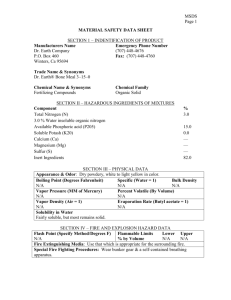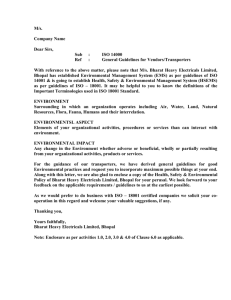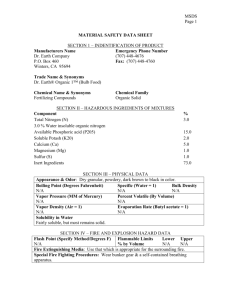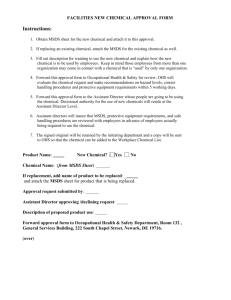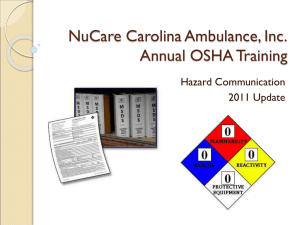Hazard Communication Information to Employees
advertisement
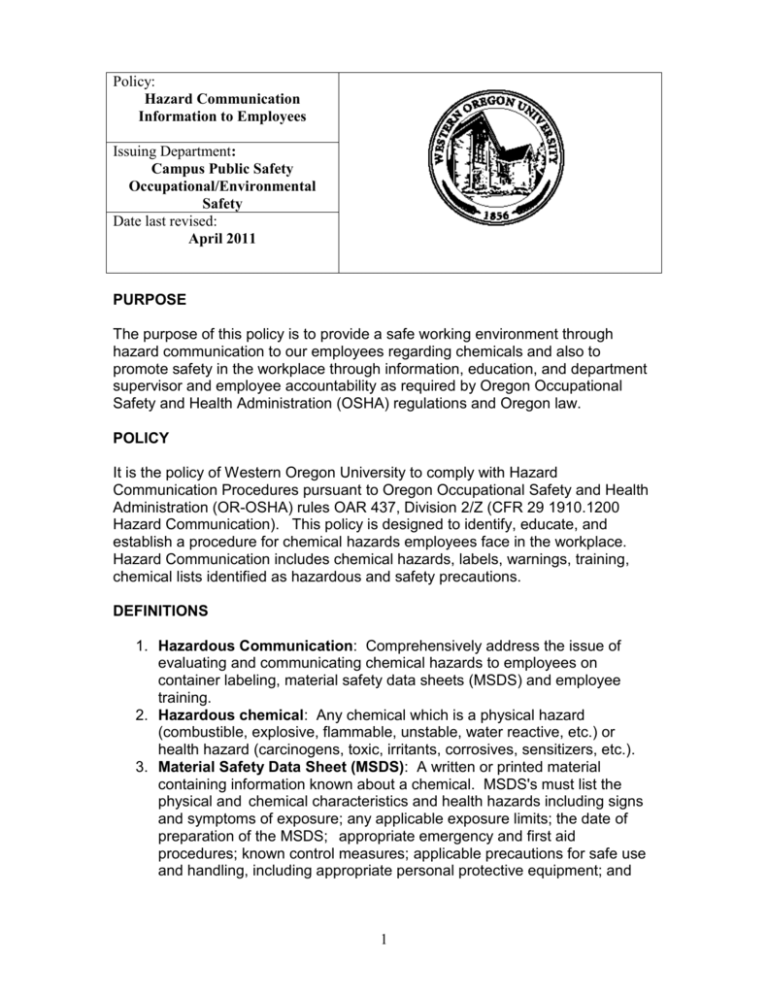
Policy: Hazard Communication Information to Employees Issuing Department: Campus Public Safety Occupational/Environmental Safety Date last revised: April 2011 PURPOSE The purpose of this policy is to provide a safe working environment through hazard communication to our employees regarding chemicals and also to promote safety in the workplace through information, education, and department supervisor and employee accountability as required by Oregon Occupational Safety and Health Administration (OSHA) regulations and Oregon law. POLICY It is the policy of Western Oregon University to comply with Hazard Communication Procedures pursuant to Oregon Occupational Safety and Health Administration (OR-OSHA) rules OAR 437, Division 2/Z (CFR 29 1910.1200 Hazard Communication). This policy is designed to identify, educate, and establish a procedure for chemical hazards employees face in the workplace. Hazard Communication includes chemical hazards, labels, warnings, training, chemical lists identified as hazardous and safety precautions. DEFINITIONS 1. Hazardous Communication: Comprehensively address the issue of evaluating and communicating chemical hazards to employees on container labeling, material safety data sheets (MSDS) and employee training. 2. Hazardous chemical: Any chemical which is a physical hazard (combustible, explosive, flammable, unstable, water reactive, etc.) or health hazard (carcinogens, toxic, irritants, corrosives, sensitizers, etc.). 3. Material Safety Data Sheet (MSDS): A written or printed material containing information known about a chemical. MSDS's must list the physical and chemical characteristics and health hazards including signs and symptoms of exposure; any applicable exposure limits; the date of preparation of the MSDS; appropriate emergency and first aid procedures; known control measures; applicable precautions for safe use and handling, including appropriate personal protective equipment; and 1 the name of the chemical manufacturer, importer, distributor, or other party responsible for preparing or distributing the MSDS. 4. Labels: Written, printed, or graphic material displayed on, or affixed to containers of hazardous chemicals. Labels must contain appropriate hazard warnings and identify the chemical as it appears on the MSDS. 5. Non-Hazardous Chemicals: The following products are exempt from the Hazardous Communication Policy: Tobacco and tobacco products; Wood or wood products, wood dust and chemicals used in wood products; Articles which do not release or otherwise result in exposure to a hazardous chemical under normal use; Foods, drugs, and cosmetics intended for personal consumption or use by employees in the workplace; Consumer products which are used in the same manner as a consumer would use the product (similar concentrations, packaged quantity, duration, and frequency of use). PROCEDURES Container Labeling (Requirements): The purpose of container labeling is to provide employees with an immediate warning about hazards of a material they may use and to direct the chemical handler to the appropriate MSDS. A container is any bag, barrel, bottle, box, can, cylinder, drum, reaction vessel, storage tank, or similar. Labeling of all containers must include: Clear listing of the contents; Any and all appropriate hazard warnings; The manufacturer's name and address. Secondary containers or portable containers intended for immediate use are not required to be labeled if the hazardous chemical will be under the control of and used only by the person who transfers it from a labeled container during the work shift in which it was transferred. If secondary containers are to be used for extended use, the containers are to be labeled with an extra copy of the original manufacturer's label or with Physical Plant Stores generic labels which have identification and hazard warning blocks. No container will be released or be in use until it meets the above requirements. 2 Material Safety Data Sheets (MSDS): MSDS are the primary means of conveying information concerning chemical hazards to employers and employees. The companies introducing the chemicals to the workplace are required to prepare the MSDS for the materials used by Western Oregon University. Each person in charge of a department or area is required to have: MSDS for each hazardous chemical present in their workplace; MSDS for all hazardous chemicals brought into the workplace by requesting them from the suppliers as necessary; MSDS maintained for future reference; MSDS readily available to employees, their representatives and OR-OSHA; A secondary copy of each MSDS maintained with Campus Public Safety. MSDS retention by Physical Plant will be 30 years from date of use. If MSDS are not available or new chemicals in use do not have MSDS, and attempts to obtain the MSDS have failed, contact the Campus Public Safety Director immediately. Material Safety Data Sheets Content: Twelve different informative items are required in each MSDS. If some of the information is unknown or not applicable, it must be stated. The twelve required items include: Identity of chemicals presenting physical or health hazards. Trade secret provisions may be exempted; Physical and chemical characteristics such as vapor pressure, flash point, and chemical stability; Physical hazards such as reactivity, explosiveness, and fire potential; Health hazards including signs and symptoms of illness, and medical conditions which might be aggravated by exposure; Primary routes of chemical entry into the body; Permissible exposure limits published and/or recommended for the chemical; Whether or not the chemical is listed as a carcinogen; Precautions necessary for safe use; Control measures known; including engineering, work practices, and personal protective equipment necessary to protect against the hazards; Emergency and first aid procedures; Date of MSDS preparation or the date of the last change in contents; Name, address, and phone number of the person responsible for the MSDS. 3 Employee Information and Training: A. Departments must provide employees, contractors, and others with documented awareness training information prior to working with chemicals: Use and location of hazardous chemicals in their area; Requirements and location of this policy; List and location of hazardous chemicals; List and location of MSDS. B. Departments are required to train employees, contractors, and others on: Type of Hazard Communication labeling system; How to obtain, read, and use MSDS and to obtain appropriate hazard information; Physical and health effects of the hazardous chemicals; Methods and observation techniques used to determine the presence or release of hazardous chemicals in the work area; How to reduce or prevent exposure to these hazardous chemicals through the use of control/work practices and personal protective equipment; Steps taken to reduce or prevent exposure to these chemicals; Safety emergency procedures to follow if the employee is exposed to these chemicals; Each employee is to sign a personal training ledger upon completion of the above information and secure in their departments MSDS book. Hazardous Chemicals List: Departments are to provide a current list of hazardous chemicals to be attached to this policy for employee access and use. Hazardous Non-routine Tasks: Prior to employees performing a hazardous non-routine task, the department is responsible for training the employee prior to the start of work on: Specific chemical hazards; Protective/safety measures employees can take (including protective equipment); Measures the vendor, contractor or entity has taken to reduce the hazards, including ventilation, respirators, presence of another employee, and emergency procedures. Hazardous Chemical Emergencies: In the event of a hazardous chemical spill, all persons are to leave the area 4 immediately and notify Campus Public Safety at 8-9000. No persons are authorized to return to the chemical spill until such time as a representative of Campus Public Safety authorizes them to. A hazardous chemical spill is not limited to, but may consist of the following: Chemical release into the environment above the manufacturer's suggested level of safety. Examples may include spilling ammonia on the floor in a closed environment. Unconsciousness of a person who may be in or around chemicals. This area should not be entered. Appropriate emergency personnel are to respond. Fume/vapor exposure may occur and cause a sense of burning or irritation to the mouth, nose, throat, chest or eyes. Dizziness, nausea, or presence of a strong odor may exist. Ventilate immediately. Skin/Eye contact with a hazardous chemical is to be treated as suggested on the first aid section of the MSDS for the chemical. Exposure to hazardous chemicals without the recommended personal protective equipment by the manufacturer may result in injury or death. At no time are employees, supervisors or other persons allowed to knowingly work in an unsafe location or manner on campus that may raise the level of exposure to a hazardous chemical. Contractor's Chemicals: Contractors, businessmen or other entities who use and/or introduce hazardous chemicals to Western while in the course and scope of their work are required to: Provide the Office of Campus Public Safety and the department(s) receiving the service, a copy of all MSDS of hazardous chemicals used prior to starting the job; Provide the length of time the chemical will be in use; Follow and adhere to Western's Hazard Communication policy; Be responsible and demonstrate compliance when inspected by OROSHA and be responsible for all associated citations and fines. AUTHORITY Oregon Administrative Rule (OAR) 437-155-015/1926.59(e) and CFR1910.1200(e)(1) Federal "Right to Know" Law. 5 RESPONSIBILITY It is the responsibility of each department to have an up-to-date Material Safety Data Sheets (MSDS) for each chemical present in their workplace. The companies introducing these chemicals to the workplace are required to prepare and provide a copy of the MSDS at the time of purchase. These are to be placed in a notebook available for easy reference and a second copy provided to the Office of Campus Public Safety for the master notebook. MSDS must be retained for 30 years from the date of use of the chemical. Accountability (Supervision): Persons with supervision oversight, including Deans, Department Heads, Faculty Chairs, Management, Directors, and Supervisors, are required to ensure all hazardous chemicals in their departments contain proper labeling, have MSDS available, and ensure employees, students, and others who come in contact or potential contact with hazardous materials are trained in accordance with this policy and the "Federal Right to Know" law. When Western is inspected by OROSHA, each department, upon request, shall be responsible to demonstrate compliance. In the event compliance is not demonstrated, the department shall be responsible for associated citations, fines and compliance plan. Date of next review: April 2012 Alternate formats of this policy are available from the Office of Human Resources. 6 HAZARD COMMUNICATION Training Ledger Instructor:__________________________Training Date:_________________ As an employee of Western Oregon University, I understand that I may be exposed to hazardous chemicals that could be physical and/or health hazards. In compliance with CFR1910.1200(e)(1), I understand the following information has been covered in training provided by my supervisor. I also acknowledge that if I do not understand part or all of the points covered, it is my responsibility to seek clarity from my supervisor. Type and how the hazard communication labeling system works; How to obtain, read and use MSDS and appropriate hazard information; Physical and health effects of the hazardous chemicals in the work area; Methods used to determine the presence or release of hazardous chemicals in the work place; How to reduce or prevent exposure to hazardous chemicals through procedures in using personal protective equipment; Emergency procedures to follow if exposed to a hazardous chemical; Location and use of hazardous chemicals; List and location of MSDS. Printed Name Signature _______________________________ __________________________ _______________________________ __________________________ _______________________________ __________________________ _______________________________ __________________________ _______________________________ __________________________ _______________________________ __________________________ _______________________________ __________________________ _______________________________ __________________________ _______________________________ __________________________ _______________________________ __________________________ 7


